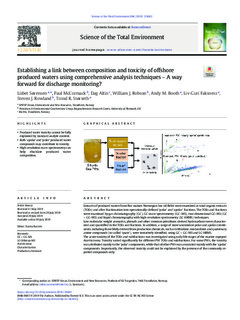| dc.contributor.author | Sørensen, Lisbet | |
| dc.contributor.author | McCormack, Paul | |
| dc.contributor.author | Altin, Dag | |
| dc.contributor.author | Robson, William J. | |
| dc.contributor.author | Booth, Andy | |
| dc.contributor.author | Faksness, Liv Guri | |
| dc.contributor.author | Rowland, Steven J | |
| dc.contributor.author | Størseth, Trond Røvik | |
| dc.date.accessioned | 2019-08-07T08:52:44Z | |
| dc.date.available | 2019-08-07T08:52:44Z | |
| dc.date.created | 2019-08-05T10:28:47Z | |
| dc.date.issued | 2019 | |
| dc.identifier.citation | Science of the Total Environment. 2019, 694 133682-?. | nb_NO |
| dc.identifier.issn | 0048-9697 | |
| dc.identifier.uri | http://hdl.handle.net/11250/2607404 | |
| dc.description.abstract | Extracts of produced waters from five mature Norwegian Sea oil fields were examined as total organic extracts (TOEs) and after fractionation into operationally-defined ‘polar’ and ‘apolar’ fractions. The TOEs and fractions were examined by gas chromatography (GC), GC-mass spectrometry (GC–MS), two dimensional GC–MS (GC × GC–MS) and liquid chromatography with high-resolution spectrometry (LC-HRMS) techniques. Low molecular weight aromatics, phenols and other common petroleum-derived hydrocarbons were characterized and quantified in the TOEs and fractions. In addition, a range of more uncommon polar and apolar constituents, including those likely derived from production chemicals, such as trithiolane, imidazolines and quaternary amine compounds (so-called ‘quats’), were tentatively identified, using GC × GC–MS and LC-HRMS. The acute toxicity of the TOEs and subfractions was investigated using early life stages of the marine copepod Acartia tonsa. Toxicity varied significantly for different PW TOEs and subfractions. For some PWs, the toxicity was attributed mainly to the ‘polar’ components, while that of other PWs was associated mainly with the ‘apolar’ components. Importantly, the observed toxicity could not be explained by the presence of the commonly reported compounds only. Although, due to the vast chemical complexity even of the sub-fractions of the PW extracts, specific compounds driving the observed toxicity could be not be elucidated in this study, the proposed approach may suggest a way forward for future revisions of monitoring regimes for PW discharges. | nb_NO |
| dc.language.iso | eng | nb_NO |
| dc.publisher | Elsevier | nb_NO |
| dc.relation.uri | https://doi.org/10.1016/j.scitotenv.2019.133682 | |
| dc.rights | Attribution-NonCommercial-NoDerivatives 4.0 Internasjonal | * |
| dc.rights.uri | http://creativecommons.org/licenses/by-nc-nd/4.0/deed.no | * |
| dc.subject | GC × GC–MS | nb_NO |
| dc.subject | LC-Orbitrap-MS | nb_NO |
| dc.subject | Acartia tonsa | nb_NO |
| dc.subject | Characterization | nb_NO |
| dc.subject | Production chemicals | nb_NO |
| dc.title | Establishing a link between composition and toxicity of offshore produced waters using comprehensive analysis techniques – A way forward for discharge monitoring? | nb_NO |
| dc.type | Journal article | nb_NO |
| dc.type | Peer reviewed | nb_NO |
| dc.description.version | publishedVersion | nb_NO |
| dc.rights.holder | © 2019 The Authors. Published by Elsevier B.V. This is an open access article under the CC BY-NC-ND license | nb_NO |
| dc.source.pagenumber | 133682-? | nb_NO |
| dc.source.volume | 694 | nb_NO |
| dc.source.journal | Science of the Total Environment | nb_NO |
| dc.identifier.doi | 10.1016/j.scitotenv.2019.133682 | |
| dc.identifier.cristin | 1713981 | |
| dc.relation.project | Norges forskningsråd: 280511 | nb_NO |
| dc.relation.project | Norges forskningsråd: 243720 | nb_NO |
| cristin.unitcode | 7566,6,0,0 | |
| cristin.unitcode | 7401,90,25,0 | |
| cristin.unitname | Miljø og nye ressurser | |
| cristin.unitname | Helse | |
| cristin.ispublished | true | |
| cristin.fulltext | original | |
| cristin.qualitycode | 2 | |

